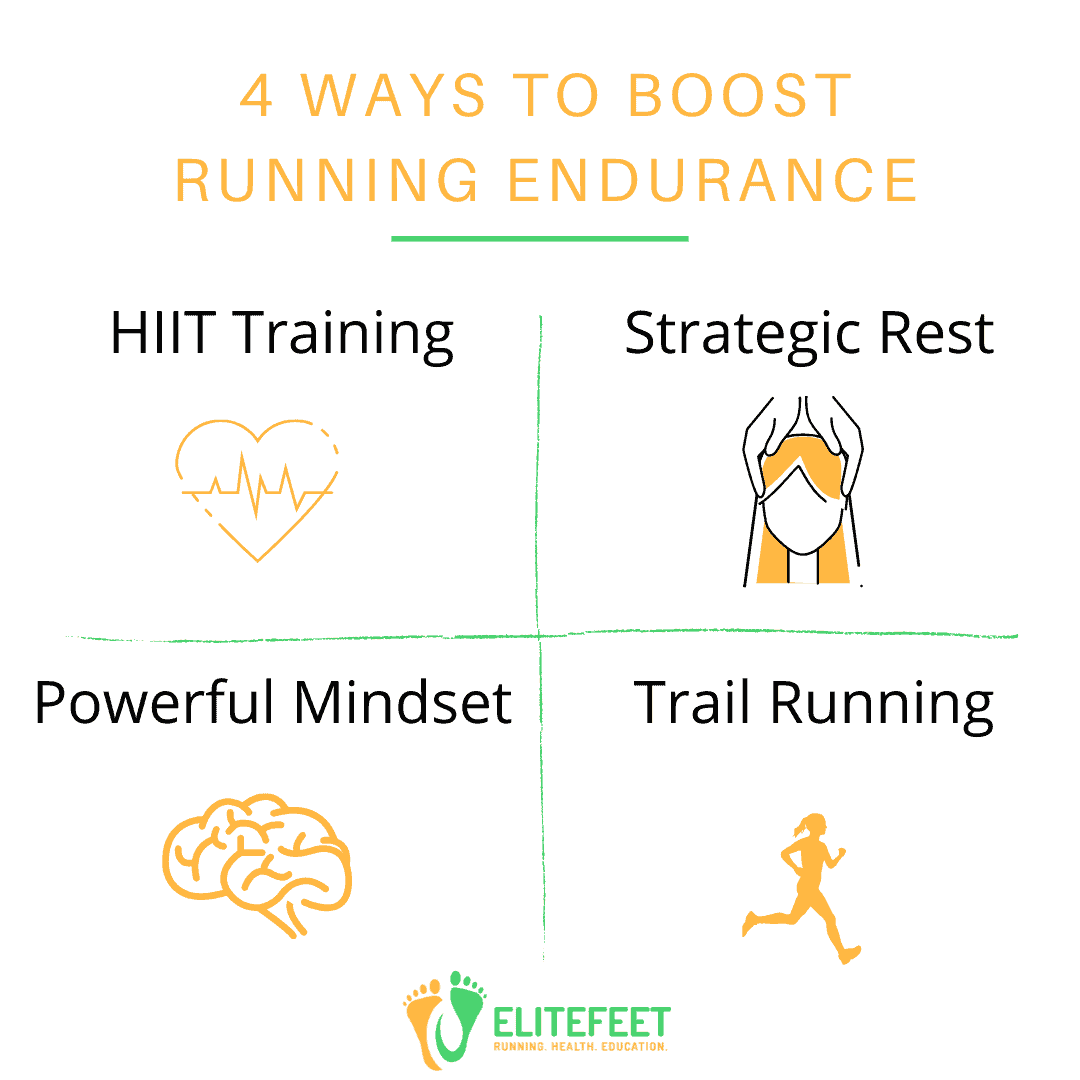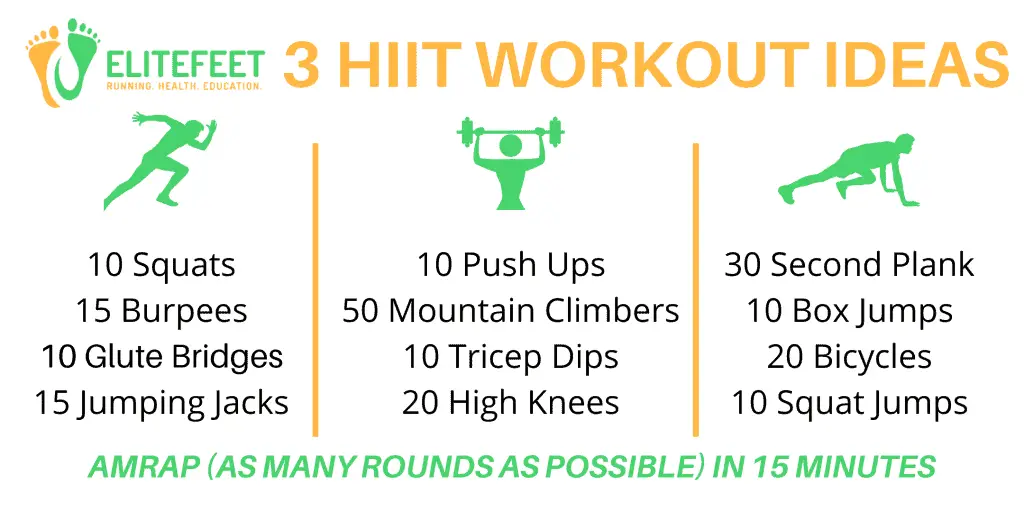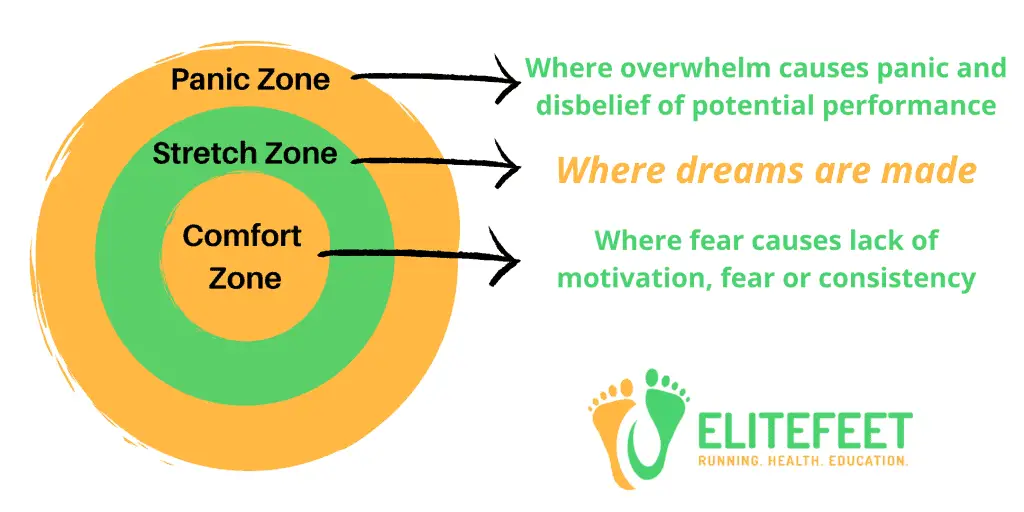At any stage in your running journey, increasing endurance running is tough. As your sweat is pouring and heart’s pounding, it’s difficult to beat your personal best in that last grueling mile.
Increasing endurance for beginners is even more of a challenge. To make that first mile easier (and boost your running endurance), consider the following four steps:
- Integrate HIIT into your running program
- Do a weekend trail run
- Rest strategically
- Build an unstoppable mindset
Contents
Start With HIIT (Off the Track)
HIIT training is high-intensity interval training. It’s an ideal form of anaerobic exercise. Anaerobic exercise breaks down glucose in the body without using oxygen. Whenever this process occurs, lactic acid begins to build up in the muscles, which leads to fatigue. By engaging in anaerobic exercise regularly, your body will be able to tolerate and eliminate lactic acid more effectively.
Have you ever had a cramp while running? That’s your anaerobic threshold chiming in to say hello. To increase running endurance for beginners, you need to lift your anaerobic threshold to run faster and longer. Even though long-distance running is aerobic training (which requires plenty of oxygen), challenging your anaerobic threshold remains crucial for significant gains.
Worried that you might have to join a gym? Don’t be. Here are a few short HIIT workouts that you can do today in the comfort of your own home.
- Complete 10 squats, 15 burpees, 10 glute bridges, and 15 jumping jacks. Do this as many times as you can within 15 minutes.
- Complete 10 push-ups, 50 mountain climbers, 10 tricep dips, and 20 high knees. Do this as many times as you can within 15 minutes.
- Complete a 30-second plank, 10 box jumps, 20 bicycles, and 10 squat jumps. Do this as many times as you can within 15 minutes.
Explore Nature With A Trail Run
Building endurance can serve as the perfect excuse to go on an adventure. Trail runs are ideal for escaping the day to day monotony of many indoor day jobs. Full of new scenery, obstacles, and hills, not only will they challenge you physically, but they provide a mental test too. Any lapse in focus (trip up on a tree root, for example) can be a humbling experience. While this does come with an obvious bit of risk, the added intensity is a great way to avoid plateauing (not to mention justification to buy the latest trail running shoes you’ve been eyeing).
As far and the physical challenge goes, training on an incline will simultaneously increase your performance on the road. If you’re a beginner, start with a brisk walk on a challenging incline, then work your way up to running. Similar to HIIT training, a trail run will improve your anaerobic threshold, as running uphill is considerably more difficult.
Live in a city? You can recreate the experience on a treadmill. Many treadmills have pre-programmed hill functions available (while the more affordable ones will allow you to change the incline manually). If you need to use a manual feature, try running for 2 minutes on a difficult incline, then 1-minute on a mid-level incline for a total of 21 minutes. This doesn’t require a ton of user-input on the fly, or you can always see if your treadmill can retain custom programming.
Harder Isn’t Always Better – Rest Strategically
Many beginner runners fall into the trap of thinking that harder is better. That’s often not the case. Over time, running will change:
- Your muscles
- Your hormones
- Your cardiovascular system
Your muscles – Running uses your glutes, hamstrings, quadriceps, hip flexors, and calves, which are all major lower body muscle groups. This is precisely why many yoga studios have classes formulated for runners. Rather than merely “power through”, take care of your muscles with proper rest and stretching. By increasing your running endurance as a beginner (in moderation), this will significantly reduce the chance of injury.
Your hormones – When you run, your hormones are under heightened levels of stress. This is because your body still subconsciously thinks that you are running from a tiger. Your sympathetic nervous system is activated, as is the fight or flight response. When you don’t integrate rest, you’ll be firing off too many stress hormones.
Your cardiovascular system – Running is perfect for your cardiovascular system (that is unless you already have a heart problem). The benefits of running include lowering blood pressure, lowered “bad” LDL cholesterol, and a reduced chance of heart disease.
If you already have any of these problems, you’ll have to work running into your training a bit more slowly, preferably under medical guidance. Increasing running endurance for beginners is a marathon, not a sprint. Some runners will need a few more rest days than others depending on experience, medical history, age, and other lifestyle factors.
Increasing Running Endurance For Beginners Is A Mind Game
Take a leaf out of David Goggins’ book and build unstoppable self-talk.
David’s research found that the first time your mind tells you that you need to stop, you’ve only reached 40% of your potential. Considering he’s been through SEAL hell week three times, achieved the world record for the highest number of pull-ups in 24 hours, and completed several ultramarathons – we’ll take his word for it.
Here’s how to create the mindset to push yourself further than ever before:
- Explore your stretch zone. Push yourself to discomfort, but not so far that you become overwhelmed. This is a process of trial and error.
- Listen to inspirational podcasts of athletes who have achieved what they first didn’t think was possible.
- Create evidence that the voice in your head is wrong. Has that inner critic ever told you not to go for a promotion out of fear, only for you to prove it wrong?
It always seems impossible until it’s done.
– Nelson Mandela
How Are You Going To Boost Your Endurance?
When you’re just starting, the journey can be tough. You need the perfect mix of mindset, strategy, and willpower. Increasing running endurance as a beginner can be surprisingly easy once you find the right balance. Starting small will allow huge-impact habits to develop over time.
Which tip is missing from your current training regime? What’s worked for you in the past? We’d love to hear from you in the comments section, as we all can benefit from learning about past experiences.











Leave A Comment